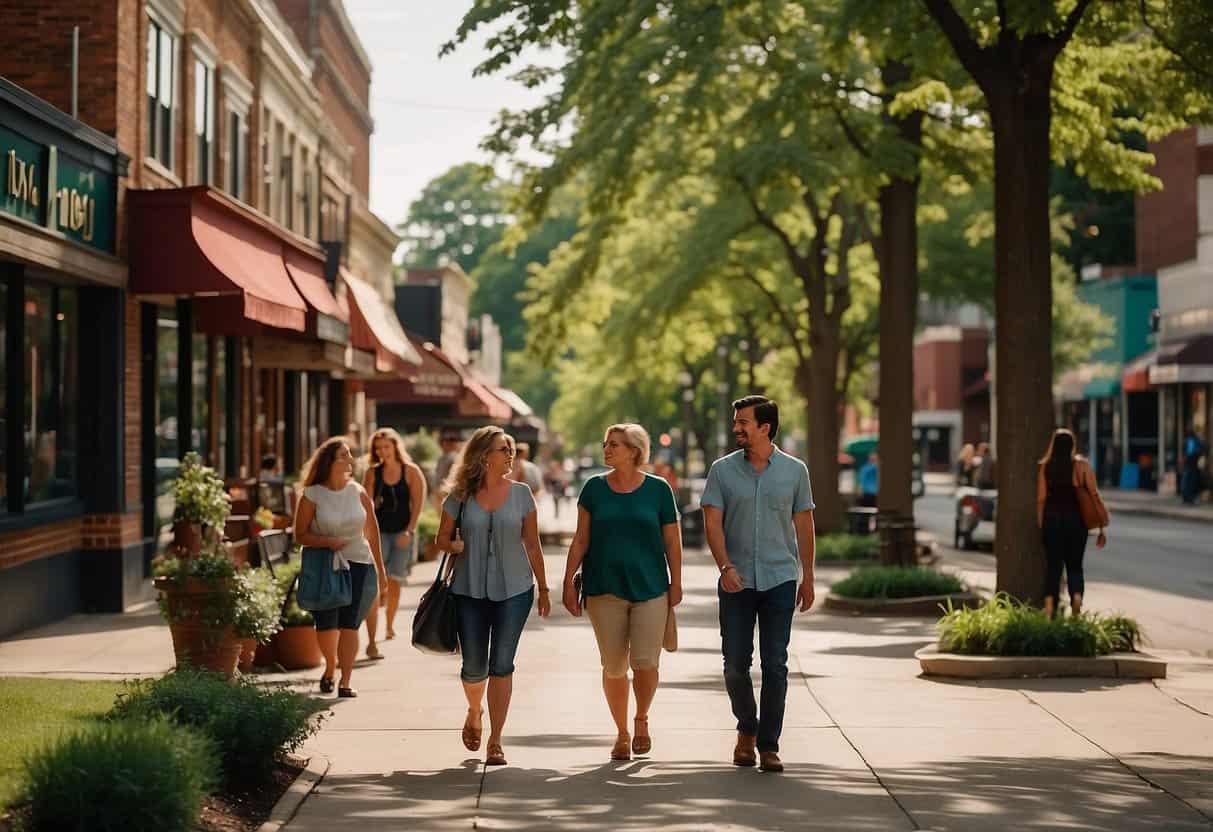For those seeking a pedestrian-friendly environment, Indiana offers several cities that cater to walkers. East Side Chicago stands out as the most walkable city in the state, boasting a walk score of 56. This suburb of the larger city of Chicago features areas like Prairie Park and Calumet Heights, which are particularly inviting to pedestrians.

Other noteworthy mentions include Hammond and Logansport, which also rank high on the walkability scale. These cities provide ample amenities within walking distance, making them ideal for those who prefer getting around on foot rather than relying on cars.
Exploring cities such as Corydon and Vincennes reveals additional walkable towns worth visiting. These charming locales invite visitors to enjoy a leisurely walk through their historic streets and vibrant neighborhoods. For more information, check out this list of most walkable cities in Indiana.
Assessing Walkability in Indiana Cities
Walkability in Indiana cities varies significantly. Several factors, such as the availability of amenities, street design, and population density, contribute to how pedestrian-friendly a city is. Walk Score is a common metric used to rate walkability and ranges from 0 to 100.
Key Factors in Walkability
- Proximity to Amenities: Access to grocery stores, schools, parks, and restaurants.
- Street Design: Presence of sidewalks, crosswalks, and traffic calming measures.
- Population Density: Denser areas generally have more connected and walkable neighborhoods.
Walkability Scores of Major Cities
| City | Walk Score | Notable Characteristics |
| East Chicago | 56 | High proximity to amenities and pedestrian-friendly areas. |
| Indianapolis | 31 | Considered car-dependent, with less pedestrian infrastructure. |
| Fort Wayne | 29 | Limited walkable areas, requiring car transport for most tasks. |
Common Challenges
Pedestrian Accidents: Safety is paramount, and cities must address pedestrian accidents through better infrastructure.
Weather: Indiana cities experience seasonal weather, impacting walkability year-round.
Urban Planning: Effective urban planning is crucial to enhance walkability. This includes creating mixed-use developments and investing in pedestrian pathways.

Understanding these elements helps in grasping why some cities in Indiana, like East Chicago, score higher in walkability compared to others like Indianapolis. Improvements in city planning and infrastructure can significantly enhance walkability and reduce dependency on cars. More details can be found on the list of walkable cities in Indiana.
Top Walkable Cities in Indiana
Indiana boasts several cities that are ideal for pedestrians. These cities offer walkable neighborhoods, cultural sites, and dedicated trails that enhance the pedestrian experience.
Carmel: A Pedestrian-Friendly Community
Carmel is known for its extensive network of pathways and roundabouts designed to prioritize pedestrians. The city features the Monon Trail, a multi-use path connecting various parks, residential areas, and the city center. Brick-lined sidewalks and pedestrian bridges ensure safety and convenience. Carmel's Arts & Design District offers easy walkability to galleries, cafes, and shops, making it a thriving area for foot traffic. The city's commitment to maintaining well-lit streets and safe crosswalks contributes significantly to its pedestrian-friendly reputation.
Bloomington: Culture and Connectivity
Bloomington combines cultural attractions with pedestrian accessibility. The B-Line Trail runs through the heart of the city, providing a scenic route for walkers while connecting key spots like the Farmers' Market and Switchyard Park. Downtown Bloomington offers numerous cultural attractions, from theaters to art galleries, all within walking distance. The presence of Indiana University adds to the vibrant, walkable atmosphere, with the campus and surrounding areas designed for ease of movement. Ample sidewalks, pedestrian zones, and well-maintained greenery make it pleasant to explore on foot.

Indianapolis: Urban Trails and Monuments
Indianapolis offers a mix of urban trails and historic landmarks perfect for pedestrians. The Indianapolis Cultural Trail serves as an eight-mile urban bike and pedestrian path that connects neighborhoods, cultural districts, and entertainment amenities. Iconic sites like Monument Circle and White River State Park are easily accessible on foot. The downtown area includes greenways and well-marked crosswalks, ensuring a safe and enjoyable experience for walkers. Bold public art installations and frequent events along these paths encourage residents and visitors to explore the city by foot.
Safety Measures and Pedestrian Accidents
Safety measures are critical in reducing pedestrian accidents. Many cities in Indiana have implemented various policies and infrastructure designed to protect pedestrians.
Indianapolis has faced significant challenges, ranking as the sixth most dangerous city for pedestrians due to its high number of fatalities in 2021. This is highlighted by 125 pedestrian deaths reported across Indiana that year.
Other cities like East Chicago and Hammond, which are among the most walkable cities in Indiana, emphasize pedestrian safety through well-lit crosswalks and sidewalks. These measures aim to enhance visibility and reduce the risk of accidents.
In Logansport, authorities have focused on maintaining clear and unobstructed pathways for pedestrians, which helps minimize collision risks. Implementing speed limits and traffic calming measures further contributes to making walking safer.
Below is a comparison of walk scores and safety features of a few cities:
| City | Walk Score | Key Safety Measures |
| East Chicago | 56 | Well-lit crosswalks, sidewalks |
| Hammond | 48 | Traffic calming measures, clear pathways |
| Indianapolis | 34 | High number of fatalities, ongoing initiatives |
Pedestrian accidents are a concern in both highly walkable cities and those with lower walk scores. Effective safety measures, such as traffic regulations and improved infrastructure, play a crucial role in minimizing these incidents. Addressing these issues requires continuous effort and commitment from city officials and communities.
Enhancing Indiana's Walkability
Efforts to make Indiana more pedestrian-friendly can significantly improve quality of life.
- Improved Infrastructure
Cities can invest in well-maintained sidewalks, crosswalks, and pedestrian signals. Proper lighting and benches enhance safety and comfort. - Mixed-Use Developments
Encouraging mixed-use zoning allows residential, commercial, and recreational spaces within walking distance. This reduces the need for car travel. - Public Transportation Integration
Reliable and frequent public transportation can complement walkability. Well-placed bus stops and transit stations make it easier to move around without a car. - Green Spaces and Trails
Developing parks, green spaces, and walking trails encourages outdoor activity. These areas provide safe routes for pedestrians and improve the aesthetic appeal of cities. - Traffic Calming Measures
Implementing measures such as speed bumps, pedestrian islands, and roundabouts can reduce vehicle speeds and enhance pedestrian safety. - Community Engagement
Involving local communities in planning and decision-making ensures that the needs and preferences of residents are met. Public feedback can guide improvements effectively. - Educational Campaigns
Promoting the benefits of walking and educating the public on pedestrian safety helps build a culture that supports walkability. - Walkability Audits
Regularly conducting audits of pedestrian pathways to identify issues and make necessary modifications keeps walkable areas in optimal condition.
Example Cities Taking Action
East Chicago has a Walk Score of 56, focusing on neighborhoods like Prarie Park, making it a leader in Indiana for walkable urban areas, according to Redfin.
Hammond also stands out with a score of 52, thanks to walkable areas such as Hessville and Woodmar, as noted by Homebuyer Weekly.





Leave a Reply